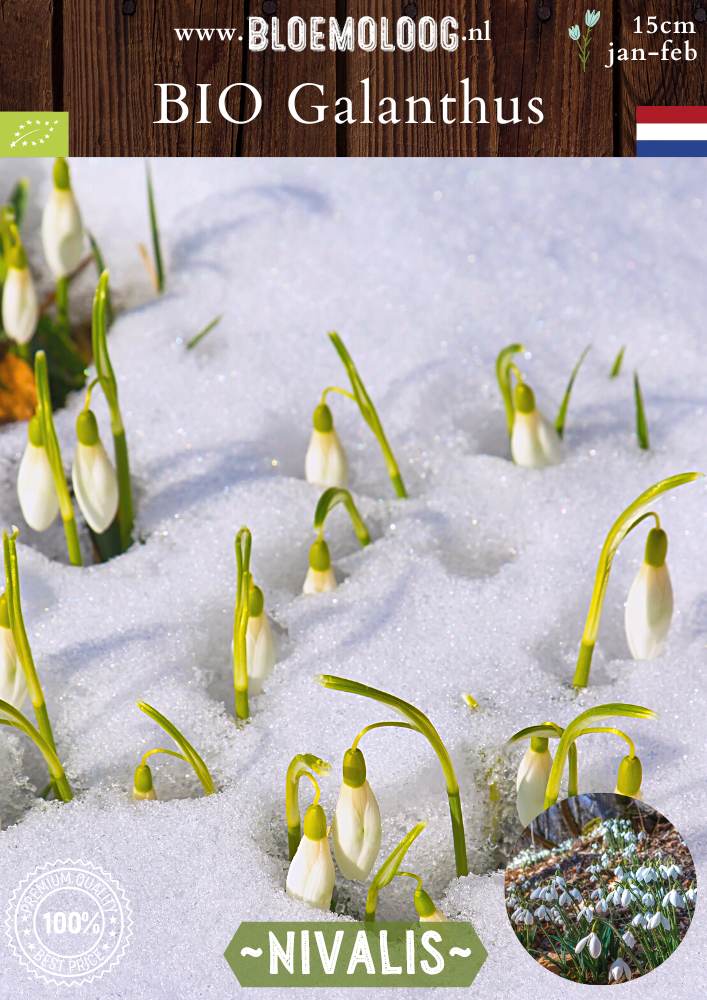Bloemoloog
Organic Galantus 'Nivalis' - Common snowdrop | 5 pcs.
Organic Galantus 'Nivalis' - Common snowdrop | 5 pcs.
Couldn't load pickup availability
Organically grown snowdrops
The common snowdrop, scientifically known as Galanthus 'Nivalis' is one of the first flowers to bloom in spring and is often considered a symbol of the arrival of spring. It grows to about 15 centimeters high and has elongated, narrow leaves. The small flowers hang down and consist of six white petals with a green marking on the inside.
The petals form a kind of bell around the central parts of the flower and when the sun rises, the shimmering flower stretches and opens fully to catch the sunlight. This creates a more open and spread out shape of the flower.
The snowdrop flowerbulbs are stored in sand at the Bloemoloog until they go into your garden. This way you can rest assured that you will receive 100% quality delivered to your home!
This product is not available on our market locations due to poor storage in outdoor temperatures!
How, where and when do I plant snowdrops?
The ideal time to plant snowdrops in the ground is from summer to November. The planting depth is 2 to 3 times the bulb height and the planting distance is 2 to 3 times the bulb width. Plant the bulbs with the point up, then cover them with soil and press gently to keep the bulb firmly in place. Provide a good watering after planting so that the soil is moist for rooting for early spring blooms.
The best location for Galanthus 'Nivalis' is in partial shade to shade, although it also has some tolerance for sunlight. Plant it in groups in the garden under deciduous trees or shrubs or in the grass around trees. Preferably in a place where there is not much walking and in the summer there is shade from the leaves of the trees.
Make sure the soil is well-drained, preferably slightly moist but not soggy. They grow well in loamy soil because this soil type retains water well, but also provides adequate drainage. They can also grow in sandy soil, provided the soil is kept sufficiently moist. Sandy soil provides good drainage, which is important to prevent rotting of the bulbs.
Although snowdrops have some tolerance for clay soil, clay that is too heavy can hinder drainage. Improving soil structure by adding organic matter such as compost or well-rotted manure can help improve drainage and promote healthy snowdrop growth.
Care of the snowdrop
Snowdrops naturalize and do not require special care. A layer of mulch, such as leaves or compost, can be helpful to keep the soil moist and reduce weed growth. Apply a thin layer of mulch around the base of the plants, but avoid covering the bulbs directly.
Give them a light organic fertilizer annually for the best results. We recommend Bio-Kultura for organic potting soil, plant food and other soil improvers!
Propagation
Snowdrops usually propagate naturally by forming new bulbs and seed dispersal. However, if you want to grow new plants, you can dig up the bulbs after flowering and carefully divide them. Plant the new bulbs immediately back in the ground at the desired location.
Origin of the snowdrop
The common snowdrop is a stinzenplant, but is native to large parts of Europe, including the western, central and southern parts of the continent.
The name Galanthus is derived from the Greek words 'gala' meaning 'milk' and 'anthos' meaning 'flower', which refers to the white color of the flowers. 'Nivalis' is derived from the Latin word 'nix' which means 'snow' and refers to the plant's flowering period in winter conditions.
Organic Galanthus 'Nivalis' - Skal NL-BIO-01 certified: 109459
Packed per 5 pieces or choose more for less in the form of a stacking discount.
STACKING DISCOUNT D
Can be ordered from June '24!
Shipping €5.95 - Free shipping from €35 purchase.
Characteristics
| Flowering time: | January - February |
| Planting time: | Straight away |
| Planting depth: | 5 cm deep |
| Planting distance: | 5 cm apart |
| Height: | 15 cm high |
| Flower diameter: | 3cm wide |
| Location: | Partial shade, shade |
| Soil PH: | Clay, loam, sandy soil - Slightly alkaline/slightly acidic |
| Winter hardiness: | Winter hardy |
| Propagation: | Good (naturalizes) |
| Origin: | Western, Central and Eastern Europe |
| Family: | Amaryllidaceae (daffodil family) |
| Colour: | White |
| Bee-friendly: | Yes |
| Fragrant: | No |
| Bulb size: | 4+ |
NL-BIO-01
To share







